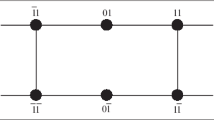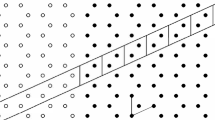Abstract
In this paper we model a graphene nano-ribbon structure by analysing an infinite 3-regular hexagonal grid which is transformed to a rectangular coordinate system or “wall”. Our goal is to solve the inverse problem of identifying the position of a single vacancy break using the lengths of the closed paths along the edges of the underlying graph. We provide an algorithm to determine the exact position of the defect by using data from at most three reference points.




Similar content being viewed by others
Code availability
Python code available on request.
References
F. Banhart, J. Kotakoski, A.V. Krashaninnikov, Structual defects in graphene. Am. Chem. Soc. 5(1), 26–41 (2011). https://doi.org/10.1021/nn102598m
M. Manoharan, H. Mizuta, Point defect-induced transport bandgap widening in the downscaled armchair graphene nanoribbon device. Carbon 64, 416–423 (2013). https://doi.org/10.1016/j.carbon.2013.07.094
I. Shtepliuk, R. Yakimova, Interband transitions in closed-shell vacancy containing graphene quantum dots complexed with heavy metals. Phys. Chem. Chem. Phys. 20, 21528–21543 (2018). https://doi.org/10.1039/C8CP03306D
P. Exner, Contact interactions on graph superlattices. J. Phys. A: Math. Gen. 29, 87–102 (1996). https://doi.org/10.1088/0305-4470/29/1/011
J. Griffith, A free-electron theory of conjugated molecules I. Polycyclic hydrocarbons. Trans. Faraday Soc. 49, 345–351 (1953). https://doi.org/10.1039/TF9534900345
B. Gutkin, U. Smilansky, Can one hear the shape of a graph? J. Phys. A: Math. Gen. 34, 6061–6068 (2001). https://doi.org/10.1088/0305-4470/34/31/301
P. Kuchment, Graph models for waves in thin structures. Waves Random Media 12, R1–R24 (2002). https://doi.org/10.1088/0959-7174/12/4/201
P. Kurasov, M. Nowaczyk, Inverse spectral problem for quantum graphs. J. Phys. A: Math. Gen. 38, 4901–4915 (2005). https://doi.org/10.1088/0305-4470/38/22/014
K. Pankrashkin, Spectra of Schrödinger operators on equilateral quantum graphs. Lett. Math. Phys. 77, 139–154 (2006). https://doi.org/10.1007/s11005-006-0088-0
Funding
This material is based upon work supported by the National Research Foundation under Grant Numbers 89147 and 103530.
Author information
Authors and Affiliations
Corresponding author
Ethics declarations
Conflict of interest
The authors declare that they have no conflict of interest.
Additional information
Publisher's Note
Springer Nature remains neutral with regard to jurisdictional claims in published maps and institutional affiliations.
Rights and permissions
About this article
Cite this article
Archibald, M., Currie, S. & Nowaczyk, M. Finding the hole in a wall. J Math Chem 58, 2313–2323 (2020). https://doi.org/10.1007/s10910-020-01178-3
Received:
Accepted:
Published:
Issue Date:
DOI: https://doi.org/10.1007/s10910-020-01178-3




